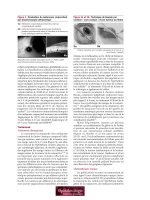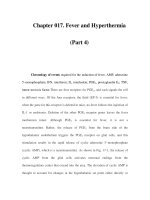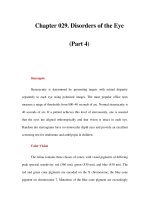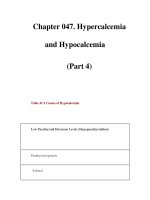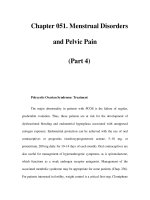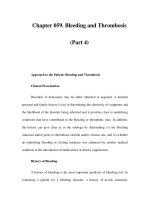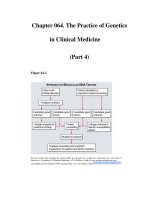Fluids and Electrolytes Demystified - part 4 potx
Bạn đang xem bản rút gọn của tài liệu. Xem và tải ngay bản đầy đủ của tài liệu tại đây (297.99 KB, 25 trang )
CHAPTER 3 General Nursing Assessments
55
Case Situation
Alea Suarez, age 24, was admitted 2 days ago after a car accident in which she
suffered a head injury with a subdural hematoma (bleeding inside the skull) and a
fracture at the base of the skull. Ms. Suarez is drowsy but oriented to person, place,
and time. Vital signs reveal blood pressure (BP) 100/30 mm Hg, pulse (P) 110
beats/minute (faint), respiration (R) 10 breaths/minute (shallow), and temperature
(T) 36.8ºC. Ms. Suarez is receiving 2 L of oxygen via nasal cannula. The nurse
notes that her urine output has increased and today is averaging 250 mL/h.
Diagnostic blood tests are done and reveal
Na
ϩ
ϭ 149 mEq/L or mmol/L
K
ϩ
ϭ 3.0 mEq/L or mmol/L
Cl
–
ϭ 119 mEq/L or mmol/L
CO
2
ϭ 32 mEq/L or mmol/L
Arterial blood-gas analysis reveals
pH ϭ 7.30
P
CO
2
ϭ 50 mm Hg
Po
2
ϭ 80 mm Hg
HCO
3
ϭ 31 mEq/L
Base excess ϭϩ3 mEq/L
Urinalysis showed a specifi c gravity of 1.010
The nurse explores the pathophysiology of head injury to determine what fl uid,
electrolyte, and acid–base imbalances Ms. Suarez is at risk for and discovers
• Head trauma can result in pituitary damage and can decrease or eliminate
ADH release (i.e., diabetes insipidus) or can cause an increase in ADH
release (i.e., SIADH).
• Respiratory controls are located in the brain and can be damaged from head
trauma or from pressure buildup in the skull owing to hematoma formation.
• Disorders in sodium, potassium, and glucose may be noted owing to
damage to the hypothalamus and pituitary that will affect the release of
hormones that control metabolism (e.g., thyrotropin-releasing hormone
[TRH] and thyroid-stimulating hormone [TSH]) and fl uids and electrolytes
(e.g., corticotrophin-releasing hormone [CRH] and adrenocorticotropin
hormone [ACTH]).
56
Fluids and Electrolytes Demystifi ed
• Aldosterone secretion may be affected, resulting in sodium, potassium,
and fl uid changes.
• Blood glucose levels may be affected, with possible hypoglycemia or
hyperglycemia with osmotic diuresis and possible ketoacidosis.
With these thoughts in mind, the nurse would examine the test results and note
• The sodium level is high possibly owing to the diuresis and a possible
lack of ADH with the head trauma. Fluid was lost but not sodium, so
hemoconcentration of sodium leads to higher levels.
• Chloride level is high owing to the link with sodium concentration.
• The potassium level is low possibly owing to loss with the diuresis.
• Specifi c gravity shows that the osmolality of the urine is low owing to the
large volumes of unconcentrated urine being produced.
• CO
2
level is high possibly owing to bicarbonate retention to balance the
respiratory acid (Pco
2
).
• pH shows an acidotic state.
• Pco
2
shows an elevation in respiratory acid indicating a respiratory acidosis.
• Oxygen level is at the low end of the normal range, presenting a risk
for hypoxemia with lactic acidosis should hypoventilation continue or
worsen.
• HCO
3
is slightly elevated; given the acidotic state, this might be the
beginning of a compensatory buffering mechanism.
• Base excess indicates elevated bicarbonate, which further supports the
buffering of respiratory acids.
The nurse is not surprised when the patient is diagnosed with diabetes insipidus
(i.e., defi cient levels of ADH) and anticipates treatment with ADH supplements and
fl uid replacement. The nurse will watch closely for fl uid retention and possible
overload in case the dose exceeds the patient’s requirements. The nurse would
monitor electrolytes and might anticipate potassium supplements for the
hypokalemia.
The diagnosis of subdural hematoma explains the depressed respirations, which
have resulted in carbon dioxide retention and respiratory acidosis. The metabolic
system is beginning to buffer the respiratory acids with retention of bicarbonate.
The nurse would watch the oxygen levels and respiratory rate closely and continue
supplemental oxygen therapy to maintain adequate oxygenation and would prepare
to artifi cially ventilate Ms. Suarez to improve CO
2
removal and total ventilatory
effectiveness.
CHAPTER 3 General Nursing Assessments
57
Final Check-up
1. Hosea, age 15 years, has had diarrhea for the past 5 days. He has been
able to drink small sips of water, but any volume taken in stimulates
more diarrhea. He is admitted to the hospital with suspected electrolyte
imbalance. Which of the following is the nurse likely to observe?
(a) Magnesium levels of 2.2 mEq/L or higher
(b) Elastic and moist skin
(c) Potassium levels of 2.5 mEq/L or lower
(d) Dilute yellow urine output
2. If a patient is low on fl uid volume, what signs might the nurse note?
(a) High levels of sodium owing to hemoconcentration
(b) Low levels of chloride owing to hemoconcentration
(c) Low levels of calcium owing to renal reabsorption
(d) High levels of magnesium owing to renal reabsorption
3. A high level of extracellular Na
ϩ
will result in what sign or symptom?
(a) Sedation
(b) Slow refl ex response
(c) Irritability
(d) Polyphagia
4. Which of the following statements is accurate about the patient at risk for a
potassium imbalance?
(a) The patient taking diuretics is at risk for hypokalemia.
(b) The patient with high magnesium levels is at risk for hypokalemia.
(c) Addison’s disease places a patient at risk for hyperkalemia.
(d) Aldosterone excess places a patient at risk for hyperkalemia.
5. If the nurse notes that a patient has a blood pH of 7.25 and a Pa
CO
2
of
50 mm Hg, what additional observations are likely?
(a) Slow respiratory rate
(b) Shallow respirations
(c) Low urinary bicarbonate levels
(d) Numbness and muscle spasm (tetany)
58
Fluids and Electrolytes Demystifi ed
References
Metheny NM. Fluid and Electrolyte Balance: Nursing Considerations, 4th ed. Philadelphia:
Lippincott, 2000.
Pagana KD, Pagana TJ. Mosby’s Manual of Diagnostic and Laboratory Tests, 3rd ed.
St. Louis: Mosby Elsevier, 2006.
Saladin K. Anatomy and Physiology: The Unity of Form and Function, 4th ed. New York:
McGraw-Hill, 2007.
Smeltzer S, Bare B, Hinkle J, Cheever K. Brunner and Suddarth’s Textbook of Medical-
Surgical Nursing, 11th ed. Philadelphia: Lippincott, Williams & Willams, 2008.
Web Sites
www.nephrologychannel.com/electrolytes/hypokalemia.shtml
www.ccmtutorials.com/misc/phosphate/page_05.htm
PART TWO
Fluid, Electrolyte,
and Acid–Base
Imbalances
Copyright © 2008 by The McGraw-Hill Companies, Inc. Click here for terms of use.
This page intentionally left blank
Fluid Volume
Imbalances:
Hypovolemia and
Hypervolemia
Learning Objectives
At the end of this chapter, the student will be able to
1
Compare and contrast hypervolemia and hypovolemia.
2
Identify patients at high risk for fl uid imbalance.
3
Distinguish symptoms of mild to extreme fl uid imbalances.
4
Identify diagnostic values associated with fl uid imbalnces.
CHAPTER 4
Copyright © 2008 by The McGraw-Hill Companies, Inc. Click here for terms of use.
62
Fluids and Electrolytes Demystifi ed
5
Discuss the potential complications related to hypervolemia and hypovolemia.
6
Determine the nursing implications related to treatments for fl uid imbalances.
Key Terms
Ascites
Dehydration
Dialysis
Edema
Fluid volume defi cit
Hydrostatic pressure
Oncotic pressure
Anasarca
Overview
Fluid makes up more than half the body’s weight and thus plays a critical role in the
function of the human body. Fluid balance is important to homeostasis. Circulation
of the nutrients and oxygen in the blood is critical to maintaining life. Of the
60 percent of body weight represented by fl uids for the average adult, the largest
amount (40 percent) is located inside the cell (i.e., intracellular), and the remainder
is extracellular fl uid (20 percent), plasma (5 percent) and interstitial fl uid (15 percent).
Water is essential for cellular function, with many reactions in the body involving
the exchange of hydrogen ions. Both an excess and a defi ciency of body fl uids
dimish the body’s ability to circulate blood effectively.
Fluid balance requires adequate intake as well as output based on fl uid levels in
the body. Water intake comes with liquids ingested (50 percent) and foods eaten
(40 percent), as well as a small amount produced in metabolic processes (10 percent).
Issues arise when patients do not take in adequate fl uid or lose excessive fl uids
owing to
Decreased intake
• Lack of access to clean water or food
• Inability to eat or drink without assistance
• Inability to chew
• Inability to swallow
• Nausea (decreasing the desire to eat or drink)
CHAPTER 4 Fluid Volume Imbalances
63
Excess loss
• Vomiting (causing problems with hydration, nutrition, electrolytes, and
acid–base balance)
• Diarrhea (causing loss of fl uids and nutrients including electrolytes)
• Malabsorption (causing fl uid and nutrient loss)
• Bleeding
• Fluid drainage (e.g., from wounds, nasogastric suctioning, etc.)
Problems also can arise with excessive body fl uids. It is uncommon for an
individual to overload his or her body with fl uid in the presence of functioning
kidneys that excrete excess water. However, in some neurologic conditions that
migh cause an individual to drink uncontrollably, hypervolemia could occur. More
commonly, excessive intake of water occurs when fl uids are infused intravenously.
Hypervolemia also can result when fl uid output is altered, such as occurs with
decreased renal function or renal failure. The normal mechanism for retaining fl uid
based on body need cannot function when the kidneys are unable to regulate release
or retention of fl uid based on body need. Regulation of body fl uids was discussed
in Chapter 1 and will be discussed again later in this chapter.
Normal Intake and Output
Humans normally will seek out fl uids because of a thirst mechanism that induces a
craving for liquids when the body needs fl uid. People who cannot access the desired
fl uids are at risk for inadequate intake. For example, people who are stranded in
areas without clean water sources are at risk for hypovolemia. Fluid defi cits are also
found in people who are unable to obtain food and fl uids without assistance (e.g.,
infants, unconscious individuals, and immobile or mobility challenged individuals)
and are not given adequate food and fl uids.
Relatedly, an individual with a blockage (e.g., a tumor) along the oral–esophageal
passage or gastrointestinal track may have diffi culty ingesting and retaining
adequate fl uids. People with chewing diffi culty may not take in inadequate fl uid-
containing foods. Individuals with diffi culty swallowing owing to obstruction or
mechanical diffi culties resulting in choking and possible aspiration of fl uid into the
lungs may experience fl uid defi cits. People with a decreased desire to ingest fl uids
owing to nausea or a decreased thirst mechanism that occurs with aging may fail to
ingest adequate fl uids.
Fluid is lost normally through the kidneys or gastrointestinal tract or as a result
of sweating and other insensible loss. When uncontrolled loss occurs, such as with
64
Fluids and Electrolytes Demystifi ed
diarrhea or profuse diaphoresis (sweating), hypovolemia can result. Similarly, if
fl uid is lost from the body through injury resulting in blood loss or wound drainage,
hypovolemia can occur.
Fluid Regulation
Fluid regulation is based on osmolality and volume triggers. As fl uid is lost from
the body,
• Extracellular fl uid increases in osmolarity.
• Fluid is drawn from the cells to decrease plasma osmolarity.
• The increased osmolality triggers the release of antidiuretic hormone
(ADH) to evoke renal retention of fl uid.
• The low fl uid volume triggers the renin–angiotensin–aldosterone
mechanism.
• Vasoconstriction occurs around the small blood amount.
• Retention of sodium and water occurs to increase blood volume.
• The atrial natriuretic peptide (ANP) mechanism, which is usually
responsible for stimulating excretion of excess fl uids, is inhibited
• The thirst mechanism is stimulated to drive the individual to seek and
ingest fl uids to increase fl uid volume in the body.
Problems arise when there is a failure or a decrease in function in any of the fl uid
regulation mechanisms. For example, in aging, the thirst mechanism is suppressed.
The elderly patient may not drink adequate fl uids owing to a lack of the thirst drive,
and hypovolemia could result. Problems also arise if the regulating mechanisms
fail to excrete excess water from the body, such as might occur with renal failure,
and fl uid overload results.
Fluid Circulation
Fluid is circulated through the body, carrying essential oxygen and nutrients to the
tissues. This circulation requires effective cardiac function to pump blood into the
blood vessels and maintain adequate, but not excessive, pressure inside the vessels
to drive fl uid out to the tissues. Adequate proteins are needed to draw fl uid back into
the blood vessels carrying metabolic waste for transport to the lungs, liver, and
CHAPTER 4 Fluid Volume Imbalances
65
intestines and kidneys for removal from the body. The process of tissue perfusion
requires a balance of pressures in the blood vessels. Hydrostatic pressure is the
force against the blood cell imposed by the fl uid volume that causes fl uid to move
out of the blood vessel and into the tissues. Oncotic pressure is the pressure exerted
by the difference in concentration between the fl uid inside the blood vessel and the
fl uid outside the blood vessel that causes fl uid to move into the blood vessel from
the tissues across a concentration gradient.
Hydrostatic pressure is high in arteries and low in veins, thus pushing well-
oxygenated blood out of the arteries and into tissues, and the drop in pressure in the
veins allows deoxygenated blood into the venous blood vessels for transport to the
heart and lungs for reoxygenation. Oncotic pressure, which is lower in the arteries
because blood is more dilute but higher in the more concentrated blood in the veins,
is a powerful force drawing fl uid back into the blood vessels (Fig. 4–1). The
strongest oncotic pressure is exerted by proteins in the blood.
The pressures inside the blood cell are affected by the overall fl uid volume in
the body, as well as by the proteins in the body that keep fl uid inside the blood
vessels. Inadequate or excessive volume inside the blood vessels could hamper the
circulation of fl uid out to or in from the tissues. The inadequate circulation that
results from fl uid imbalance could cause irreversible cell damage and system
failure.
Often fl uid shifts will involve electrolyte changes as well. Sodium (and chloride)
often will move with water; thus loss of sodium can result in loss of water, and vice
versa. On occasion, drugs or hormones can cause a loss of sodium but retention of
water; this causes hypervolemia and dilution of sodium content in the body, resulting
in a relative hyponatremia. The fl uid is hypotonic (low osmolality), causing fl uid to
move into cells and resulting in cellular swelling
A loss of fl uid from the body without loss of sodium can lead to hypovolemia
and concentration of sodium and hypernatremia. Fluid then is hypertonic and can
cause cellular shrinkage owing to fl uids moving out of cells in an attempt to balance
the hypertonic fl uid. The symptoms of fl uid imbalance can be accompanied by
symptoms of electrolyte imbalance and shifts in other electrolytes that occur in an
attempt to balance electrolytes.
Hydrostatic pressure (high→ fluid out)/Oncotic pressure (low→ fluid out) Artery
Hydrostatic pressure (low→ fluid in)/Oncotic pressure (high→ fluid in) Vein
Figure 4–1 Relationship between hydrostatic pressure and oncotic pressure in the
arteries and veins.
66
Fluids and Electrolytes Demystifi ed
Hypovolemia
Hypovolemia is a defi ciency of body fl uid that results when there is a total decrease
in the fl uid volume in the body or a relative decrease in body fl uid owing to fl uid loss
from the blood vessels into the tissues. Hypovolemia can be classifi ed as fl uid
volume defi cit—the loss of water and sodium from the body—or as dehydration—
the loss of water from the body in excess of sodium, resulting in an increased
osmolality. While hypovolemia has signifi cance relative to circulatory needs, loss of
fl uid accompanied by changes in osmolality and sodium concentration in the body
has a more profound impact on the body and survival. The detrimental result is that
• Less blood volume is available to carry critical oxygen and nutrients to the
tissues.
• Loss of water could interfere with cell function.
• Electrolyte imbalance and osmolality change could accompany water loss.
• Cell shrinkage or swelling could occur depending on the osmolality
change.
• If tissues such as the brain and the heart are deprived of vital circulation,
tissue death can occur.
• Tissue death can be followed by organ failure and death.
Fluid volume defi cit occurs in situations such as
• Hemorrhage
• Diarrhea
• Prolonged vomiting
• Severe burns
• Less commonly, aldosterone defi cit (Addison’s disease), in which the
body loses or fails to conserve fl uid and sodium, and circulating volume is
decreased—the serum osmolality is essentially unchanged
5
The low blood pressure that results from the loss of hydrostatic pressure in the
blood vessels triggers the regulatory mechanisms that attempts to restore hydrostatic
pressure with vasoconstriction and reserve fl uid by decreasing loss through the
kidneys and increasing intake. Hypovolemia stimulates
• The release of renin and then angiotensin II and eventually aldosterone
• Vasoconstriction to attempt to maintain blood pressure and circulation
(renin)
CHAPTER 4 Fluid Volume Imbalances
67
• The reabsorption of sodium and water (aldosterone) to restore volume
• The thirst center in an attempt to restore volume through increased intake
In dehydration, fl uid volume is also decreased, but there is an increase in the
osmolality of the blood because an equivalent amount of sodium was not lost. This
form of hypovolemia occurs when fl uid is lost but not replaced because the
individual is unable to drink (e.g., an infant, an unconscious child or adult, or
someone stranded without access to drinkable water) or did not experience the
normal thirst impulse (e.g., elderly persons). The result would be a loss of water
without replacement and without an equal loss of sodium, resulting in an elevation
in sodium concentration in the blood and increased serum osmolality. Dehydration
can occur through such mechanisms as profuse sweating, diuresis (e.g., in diabetes
insipidus [defi cient ADH] or diabetes mellitus and osmotic fl uid loss), or excessive
diuretic use.
2
CAUSES AND SYMPTOMS
The causes of hypovolemia are inadequate intake or excessive output of fl uid and
may include
• Fluid loss through diarrhea
• Fluid loss through vomiting
• Overuse of diuretics
• Trauma or disease of the kidney
• Blood loss
• Burns
• Edema = fl uid in body tissues (e.g., anasarca or ascites)
Depending on the type of fl uid loss and replacement of fl uids, hypovolemia can
be one of three forms (relative to the sodium loss):
• Isotonic hypovolemia—when water and sodium are lost, such as with
diarrhea
• Hyponatremic hypovolemia—when water and sodium are lost, but only
water is partially replaced without an equivalent sodium replacement
• Hypernatremic hypovolemia—when water and sodium are, lost but only
sodium is replaced with insuffi cient water replacement
The body has compensatory mechanisms to maintain circulation to vital organs
for as long as possible and sends messages to stimulate the individual to take in
68
Fluids and Electrolytes Demystifi ed
fl uids, such as thirst, and to reserve fl uids through the kidneys and bowel. If fl uid is
not restored in a timely manner, severe damage can occur to tissues as compensatory
mechanisms begin to fail.
3
Symptoms and compensatory mechanisms for hypovolemia include the
following:
• Vasoconstriction maintains the blood pressure (hydrostatic pressure)
needed to propel fl uid containing needed oxygen and nutrients out of the
blood vessels and into the tissues.
• Vasoconstriction shifts blood from certain areas of the body, such as the
skin and gastrointestinal tract, which are considered less critical areas, to
provide circulation to the brain and other vital tissues.
• An additional automatic response decreases perfusion to the kidneys. This
serves multiple purposes, including decreasing loss of fl uids through the
urine; thus urinary output decreases, signaling a low fl uid volume.
• As compensatory mechanism begin to fail, neurologic symptoms such as
confusion, irritability, and progressive loss of consciousness may manifest.
• The low perfusion pressure to the kidneys triggers feedback mechanisms
such as the renin–angiotensin–aldosterone system to stimulate
vasoconstriction and reabsorption of sodium and water in an attempt to
increase fl uid volume.
Although urine output will vary among individuals, the minimum output of 30 mL/h
(less in infants and children) is used to gauge adequate renal perfusion and function,
but high urine outputs can occur in the presence of certain types of renal failure, so
this is not always a conclusive measure.
The limited fl uid volume results in decreased stroke volume in the heart. In order
to maintain cardiac output, the heart rate increases:
CO (cardiac output) ϭ SV (stroke volume) ϫ HR (heart rate)
Thus tachycardia occurs. In addition, to maximize the oxygenation of the little
blood that is circulating, and because the tissues will become hypoxic, resulting in
a metabolic acidosis, the respiratory system will be triggered to increase respiratory
rate, and thus tachypnea is noted.
Compensatory mechanisms can last for a time but are costly owing to the
increased workload placed on the heart and lungs at a time when limited nutrients
are being delivered to tissues. The speed of onset of hypovolemia is important
because patients with rapid fl uid loss will have limited opportunity for compensatory
mechanisms to slow the impact of the fl uid defi cit. The underlying problem must be
corrected to reverse the hypovolemia before compensatory mechanisms fail.
CHAPTER 4 Fluid Volume Imbalances
69
Types and Causes of Hypovolemia
A common cause of true hypovolemia is dehydration owing to inadequate intake
of fl uids, excessive loss of fl uids, or a combination of the two. Dehydration is a
true danger in the elderly because the thirst mechanism, which stimulates one to
drink fl uids, is diminished with age. Additionally, children, whose total-body fl uid
content is high and have high fl uid needs, can dehydrate more quickly than adults
if they are ill and nausea or gastrointestinal upset causes them to refuse fl uid
intake.
2
Additional causes of hypovolemia include loss of fl uids through
• Perspiration
• Vomiting
• Diarrhea
These conditions occur often in conjunction with infection or another condition
that causes patients to refuse oral intake and will compound the dehydration
experienced.
Blood loss through slow, prolonged bleeding or rapid bleeding also will cause
hypovolemia. The degree and duration of the decreased fl uid intake, prolonged
vomiting or diarrhea, or blood loss will determine the severity of the hypovolemia
and the amount of fl uids needed to restore volume.
Relative hypovolemia can occur when a large portion of the body’s fl uids escape
into the tissues, most often owing to low oncotic pressures as a result of decreased
protein. The circulating blood volume is decreased, which reduces venous return
and results in symptoms similar to those of inadequate intake or fl uid loss from the
body. Symptoms of hypovolemia can occur when the total volume of fl uid in the
body is adequate. If an excess amount of fl uid volume remains in the tissues,
decreased volume in the blood vessels will result.
Relatedly, if the fl uid in the blood vessels pools owing to vasodilation, which
decreases hydrostatic pressure in the arteries, blood volume circulating through the
vessels and moving out to the tissues is decreased, and symptoms of hypovolemia
result (Fig. 4–2).
Arteries Hydrostatic pressure (low due to pooled volume )/Veins (higher than normal)
blood pools…blood pools- → slow blood flow/slow venous reabsorption → Edema in
tissues
Figure 4–2 Relationship between hydrostatic pressure and blood fl ow in the arteries
and veins.
70
Fluids and Electrolytes Demystifi ed
Thus any condition that reduces the protein level in the blood will cause fl uids to
remain in the tissues. This causes massive edema and a reduction in circulating
blood volume. In addition, any condition that causes massive vasodilation, for
example, a systemic infection (sepsis), can cause a relative hypovolemia. In sepsis,
• Massive vasodilatation occurs
• Blood pools
• Blood fails to circulate
3
The compensatory mechanisms described earlier will be seen. However, as
stated earlier, these mechanisms can sustain life for only a limited time, and the
hypovolemic state and underlying cause must be resolved.
Symptoms of Hypovolemia
3
The compensatory mechanisms include decreasing perfusion to the kidneys to
preserve volume and other mechanisms that result in such symptoms as
• Oliguria
• Skin feeling cool to touch owing to constriction of skin blood vessels
• Tachycardia in an attempt to circulate more blood
• Tachypnea in an attempt to increase the oxygen supply to the tissues
• Decreased capillary refi ll (> 5 seconds)
• Dry mucous membranes (e.g., a dry tongue)
• Orthostatic hypotension (i.e., dizziness on standing up from a seated or
reclining position owing to a drop in cerebral blood pressure)
• Cool extremities (e.g., cool fi ngers)
• Blanching of skin, which will result in a prolonged pallor
• Dry skin
• A weak pulse
• Decreased skin turgor (i.e., when the skin is pinched, it will reveal a slow
return to original position)
Table 4–1 provides a summary of the symptoms of hypovolemia.
As stated in chapter 3, laboratory values often will reveal an elevated hematocrit,
high specifi c gravity, and increased osmolarity. Initially, the blood pressure may
remain within normal range or even may be slightly elevated owing to compensatory
vasoconstriction, but as compensatory mechanisms fail, blood pressure will
decrease. If blood pressure drops below a certain level, the hydrostatic pressure
CHAPTER 4 Fluid Volume Imbalances
71
within the blood vessels (i.e., perfusion pressure) will be too low to send fl uid out
of the blood vessels to perfuse the tissues.
1
NURSING IMPLICATIONS IN TREATMENT
Treatment of the underlying problem is critical to resolution of hypovolemia.
• If blood loss has occurred, one or more blood transfusions may be given.
• If dehydration has occurred, fl uid volume may be restored orally or through
intravenous fl uids.
• Often fl uid loss in accompanied by electrolyte loss (e.g., with perspiration,
vomiting, or diarrhea); thus fl uid replacement includes electrolyte
replacement as well.
• If the hypovolemia is relative and related to fl uid moving into the tissues
owing to a lack of protein and osmotic pressure in vessels, treatment will
center on increasing protein (i.e., infusing albumin) in the blood vessels to
bring volume into the blood vessels from the tissues.
• If blood volume is pooled, treatment may focus on eliminating the sepsis
that causes the vasodilation so that blood pressure is restored.
• While treating sepsis, fl uids may be given.
The nurse must monitor the patient closely during and after fl uid replacement
therapy because as fl uid returns to the blood vessels from the tissues or as blood
vessels constrict to normal diameter, fl uid volume overload can result.
SPEED BUMP
SPEED BUMP
1. Which of the following patients would be at greatest risk for organ damage
owing to hypovolemia?
(a) An 80-year-old man with slow blood loss of 1 pint over 5 months
(b) A 5-year-old child with diarrhea for the past 3 hours
(c) A 50-year-old woman with urinary output of 300 mL/h for 4 days
(d) A 20-year-old woman with nausea and vomiting over the last 24 hours
Table 4–1 Symptoms of Hypovolemia
Confusion, decreased sensorium
Stomach: Decreased bowel sounds
Skin (arms, trunk, and legs): Coos and pale
Kidney: Decreased urine output, concentrated urine
72
Fluids and Electrolytes Demystifi ed
2. Which of the following symptoms indicate a complication that is likely to occur
with prolonged hypovolemia?
(a) Cardiac failure owing to workload from high cardiac output
(b) Respiratory depression owing to decreased stimulation of the breathing
impulse
(c) Edema in the extremities and abdomen owing to fl uid movement into the
tissues
(d) Increased blood levels of waste products owing to decreased renal perfusion
3. The nurse suspects that Mrs. Grendal is hypovolemic. What data would support
this suspicion?
(a) A decreased respiratory rate
(b) An elevated pulse rate
(c) A decreased osmolarity
(d) An elevated urinary output
4. What treatment would be most appropriate for a patient with hypovolemia ow-
ing to massive sepsis?
(a) Blood and blood product transfusion
(b) Vasopressors such as epinephrine
(c) Vasodilators such as nitroglycerin
(d) Diuretics such as furosemide
Hypervolemia
Hypervolemia is an overload of body fl uid that results when there is an excessive
intake or decreased excretion of fl uids. When the total volume of fl uid in the
body is increased, the workload on the heart and the pressure on the blood vessels
are increased. As the hydrostatic pressure in the arterial blood vessels is
increased,
• The pressure in the veins remains higher than normal.
• The fl uid that was driven out into the tissues from the arteries is drawn back
into the veins to a lesser degree.
• The increased fl uid in the tissues results in edema.
• If the volume circulating becomes too excessive, the heart may become unable
to handle the extra workload, and congestive heart failure could result.
CHAPTER 4 Fluid Volume Imbalances
73
Patients with weakened hearts, including the elderly, who often have decreased
cardiac capacity to adapt to volume changes, or pediatric patients, who have smaller
hearts with less capacity to handle large volumes, are at particular risk for cardiac
overload.
2
Increased fl uid volume also could cause a dilutional hyponatremia.
Thus symptoms of low sodium concentration with fl uid shifts including cerebral
edema could occur.
4
TYPES AND CAUSES OF HYPERVOLEMIA
Conditions that result in hypervolemia that involve excessive oral fl uid intake are
not common. A more likely cause of excessive fl uid intake is accidental excessive
infusion of fl uids during intravenous therapy or during surgery resulting in overload.
The most common conditions resulting in hypervolemia, however, include
• Insuffi cient renal function
• Failure of the renal system
When kidney tissue is damaged, the selective function governing excretion of fl uid
into the urine to control blood volume fails to function, and excessive fl uid is
retained with overload resulting.
Less common conditions include
• Tumors
• Central nervous system (CNS) disorders
• Pulmonary disorders
• Drugs
These conditions may result in excess fl uid retention through an endocrine condition
called the syndrome of inappropriate antidiuretic hormone secretion (SIADH).
These less common conditions result in retention of water and secretion of sodium,
leading to a hypervolemia with hyponatremia.
1 2
SYMPTOMS OF HYPERVOLEMIA
Signs and symptoms indicating the presence of hypervolemia include
• Signs of cardiac failure/congestive heart failure owing to fl uid overload
• Rales in the lungs
• Jugular vein distension
• Systemic edema (i.e., anasarca = total body tissue edema or swelling)
74
Fluids and Electrolytes Demystifi ed
• Fluid buildup in the abdominal cavity (i.e., ascites = fl uid in abdominal
cavity)
• Weight gain owing to the high fl uid volume
• Decreased perfusion to the kidneys owing to heart failure
• Decreased renal output
• Urinary output, if kidneys are functional (without SIADH), may be slightly
increased, particularly as cardiac failure resolves and perfusion to kidneys
is fully restored
• Symptoms of hyponatremia, such as anorexia, nausea, and malaise
• Neurologic symptoms ranging from headache to coma owing to electrolyte
imbalance and fl uid shifts with cerebral edema
NURSING IMPLICATIONS IN TREATMENT
6
The treatment of hypervolemia involves diuretics if kidney function is suffi cient.
The nurse must
• Monitor intake and output continuously.
• Monitor weight daily.
• Watch for signs of electrolyte imbalances that may result from diuretic
therapy:
4
• Hypokalemia
• Hyponatremia
• Hypophophatemia
• Hypercalcemia
• Hypomagnesemia
• Assess signs of dehydration and hypovolemia, including
• Poor skin turgor
• Dry mucous membranes
• Orthostatic hypotention
• Decreased urine volume (< 30 mL/h)
• Dark yellow, concentrated urine
For some patients, dialysis is needed to remove the excess fl uid. Dialysis, the
fi ltering of blood through an artifi cial kidney (or the peritoneal lining) to remove
excess fl uid and waste products, can be performed directly through hemodialysis
with rapid fi ltration or through peritoneal dialysis with slower fi ltration across the
CHAPTER 4 Fluid Volume Imbalances
75
peritoneal lining. Fluid shifts will affect blood pressure and tissue perfusion; thus
the speed of dialysis is important and will have an impact on the symptoms of
distress noted because of the rapid fl uid and electrolyte shifts. The nurse must
monitor for signs of fl uid overload prior to the procedure and for signs of fl uid
defi ct, as well as electrolyte defi cit, after the procedure.
The primary electrolyte imbalance associated with the hypovolemia, a loss of
sodium (i.e., hyponatremia), may require sodium infusions until the underlying
condition has been resolved. Since electrolytes may shift in response to sodium
imbalances, other replacements may be indicated (see Chapter 5).
The nurse should monitor for patient response to treatment, particularly noting
laboratory values and vital signs. It is most important to monitor intake and output
and to note signs of hypovolemia that might occur if the degree of volume overload
is overestimated and the treatment is excessive. Hold diuretics until the primary-
care provider is consulted.
6
Conclusion
Fluid volume imbalance has great implications for a patient. Excess or insuffi cient
fl uid volume could result in poor tissue perfusion. Some patients are at high risk for
imbalance owing to young or extreme age or preexisting conditions, such as
infection or gastrointestinal upset. The causes of hypovolemia or hypervolemia vary
from altered intake—insuffi ent or excessive intake—to altered fl uid reabsorption or
excretion. Key points in this chapter include
• Body fl uid is critical to life.
• Circulation of body fl uid depends on cardiac function and maintaining
adequate pressure in blood vessels.
• Hydrostatic pressure results from fl uid volume and pushes fl uid out into
tissues.
• Oncotic pressure relates to the concentration of intravascular fl uids that
pulls fl uid back into the veins.
• Hypovolemia can result from excessive diuresis or insuffi cient fl uid intake.
• Hypervolemia can result from insuffi cient fl uid excretion owing to renal
failure or hormonal imbalance.
• Hypovolemia can be relative if fl uid escapes into the tissues or pools in
dilated blood vessels.
• Treatment of one fl uid imbalance could result in the opposite imbalance if
care is not exercised.
76
Fluids and Electrolytes Demystifi ed
Final Check-up
1. Pete, a 5-year-old patient, is admitted to the emergency room with a
history of vomiting and diarrhea over the past 3 days. His mother is
concerned because she noticed that Pete is less awake and less active than
usual and will not even watch his favorite television program. Vital signs
reveal a blood pressure of 70/20 mm Hg, a pulse rate of 140 beats/minute,
and a respiratory rate of 45 breaths/minute. The nurse is concerned that
a fl uid imbalance is present. Which of the following fi ndings would the
nurse likely observe that would support the concerns regarding fl uid
imbalance?
(a) Urine output is 40 mL/h.
(b) The patient is awake and alert.
(c) The skin is loose and nonelastic.
(d) The skin is cool to the touch.
2. Which of the following questions would provide the most important data to
further support the nurse’s concerns?
(a) What has Pete eaten today?
(b) Which television program does Pete like the most?
(c) What type of activities does Pete usually participate in?
(d) What has Pete had to drink over the last 3 days?
3. The nurse would anticipate what treatment initially for Pete?
(a) A high-protein diet
(b) Push 50–100 mL of fl uids hourly
(c) Sodium infusions over 3 days
(d) Antibiotics in intravenous fl uids
4. Which would be the most accurate explanation for Pete’s vital sign
readings?
(a) Pete is lethargic owing to the dilutional hyponatremia.
(b) The elevated blood pressure is due to increased hydrostatic pressure.
(c) Pete’s decreased pulse rate is due to decreased circulating blood.
(d) The respiratory rate is increased to compensate for poor circulation.
CHAPTER 4 Fluid Volume Imbalances
77
5. The nurse would monitor for what signs to prevent the treatment provided
to Pete from being excessive?
(a) Pete begins to watch the television in his room.
(b) The nurse hears rales in Pete’s lung fi elds.
(c) Pete’s urine output remains at 50 mL/h for 3 hours.
(d) Skin turgor testing reveals a slow return to normal position.
References
Saladin K. Anatomy and Physiology: The Unity of Form and Function, 4th ed. New York:
McGraw-Hill, 2007.
Pagana KD, Pagana TJ. Mosby’s Manual of Diagnostic and Laboratory Tests, 3rd ed.
St. Louis: Mosby Elsevier, 2006.
Needham A. Comparative and Environmental Physiology Acidosis and Alkalosis. 2004.
Web Site
/>This page intentionally left blank
Sodium Imbalances:
Hyponatremia and
Hypernatremia
Learning Objectives
At the end of this chapter, the student will be able to
1
Compare and contrast hyponatremia and hypernatremia.
2
Identify patients at high risk for sodium imbalance.
3
Distinguish symptoms of excess and defi cient sodium levels.
4
Identify diagnostic values associated with sodium imbalances.
CHAPTER 5
Copyright © 2008 by The McGraw-Hill Companies, Inc. Click here for terms of use.

